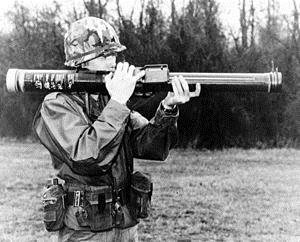Anti-tank warfare arose as a result of the need to develop technology and tactics to destroy tanks during the First World War. Since the first tanks were developed by the allies in 1916 but not principally used till 1917 the first anti-tank weapon was developed by Germany. It was a scaled-up bolt-action rifle designated the Mauser Tank-Gewehr Model 1918 that fired a 13mm cartridge with a solid bullet that could penetrate the thin armor of tanks of the time and destroy the engine or ricochet inside killing occupants. Because tanks represent an enemy's greatest force projection (aside from nuclear artillery and tank vs. tank engagements), anti-tank warfare has been incorporated into the doctrine of nearly every combat service since. The predominant anti-tank weapons at the start of the Second World War were the tank-mounted gun, limbered (towed) and anti-tank grenades used by the infantry as well as ground-attack aircraft such as the Junkers Ju 87 Stuka. Anti-tank warfare evolved rapidly, particularly on the Eastern Front, to include new infantry and infantry support weapons such as the bazooka, anti-tank combat engineering, specialized anti-tank aircraft and self-propelled anti-tank guns (tank destroyers). Both the Soviet Red Army and the German Army developed methods of combating tank-led offensives, including deployment of static anti-tank weapons embedded in in-depth defensive positions, protected by anti-tank obstacles and minefields, and supported by mobile anti-tank reserves and ground attack aircraft. From the Korean War to the Cold War, The United States, Soviet Union and other countries faced the possibility that a nuclear weapon could be detonated over an area of tank concentration in one strike. While technology was developed to protect crews of armored vehicles from the effects of radiation, the same could not be done for all their supporting arms and the supply train on which tanks depend for spares, fuel and maintenance. In the NATO countries little if any development took place on defining a doctrine of how to use armed forces without the use of tactical nuclear weapons. In the Soviet sphere of influence the legacy doctrine of operational maneuver was being theoretically examined to understand how a tank-led force could be used even with the threat of limited use of nuclear weapons on the European battlefield. The solution they arrived at was maneuver warfare while massively increasing the number of anti-tank weapons. To achieve this, Soviet military theorists (such as Vasily Sokolovsky) realized that anti-tank weapons had to assume an offensive role rather than the traditionally defensive role of the Great Patriotic War by becoming more mobile. This led to the development of improved guided anti-tank missiles, though similar design work was being performed in Western Europe and the United States. The French SS.10 missile was the first successfully used in anti-tank combat—by the Israel Defense Forces during the Suez Crisis of 1956, but the impact of Soviet anti-tank missile tactics was not evident until 1973, when Russian 9K11 Malyutka (Sagger) missiles were used by the Egyptian and Syrian armies during the Yom Kippur War against Israel. The outcome suggested that although the French missiles were a threat, they could be countered. The explosive power delivered by the missiles convinced NATO tank designers to continue their emphasis on increased armor, while Soviet designers retained their emphasis on mobility of tank-led forces. The utility of the light anti-tank weapon was also recognized by both sides of the Cold War and led to further development of man-portable weapons used by the infantry squad, while heavier missiles were mounted on dedicated missile tank-destroyers, including dedicated anti-tank helicopters, and even heavier guided anti-tank missiles launched from aircraft. Also being developed were new varieties of artillery munitions in the form of top-attack shells, and shells that were used to saturate areas with anti-armor bomblets. Helicopters could be used as well to rapidly deliver scattered anti-tank mines. Since the end of the Cold War in 1993, the only major new threats to tanks and other armored vehicles, has been the remotely detonated improvised explosive devices (IED's) used in asymmetric warfare and weapon systems like the RPG-29 and FGM-148 Javelin, which can defeat reactive armor or shell armor. The latter weapon systems use a tandem warhead where the first stage of the tandem warhead activates the reactive armor, and the second stage of the tandem warhead defeats the shell armor by means of a High Explosive Anti Tank (HEAT) shaped charge.




Comment
0